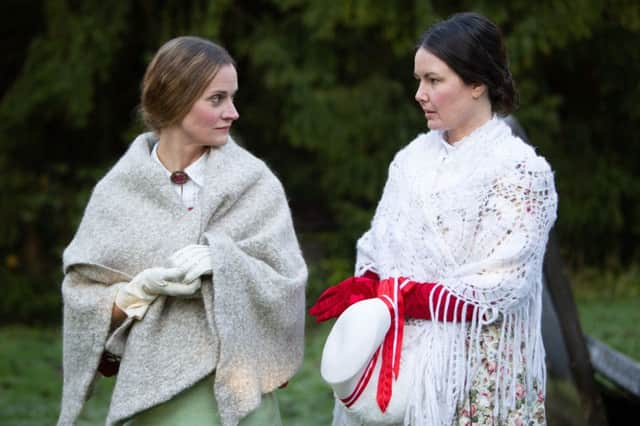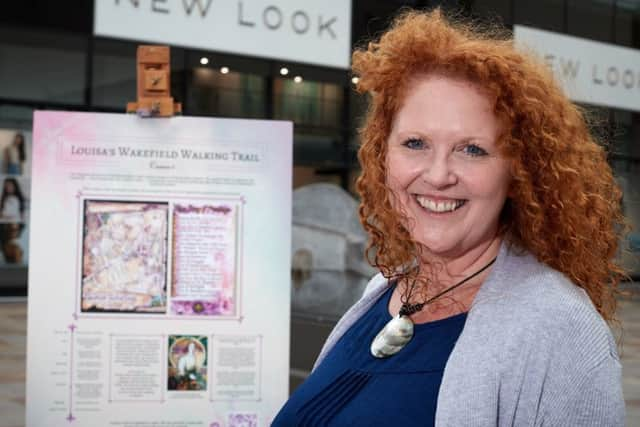High hopes that film on Wakefield diarist Clara Clarkson could see TV success on scale of Gentleman Jack


After seeing Suranne Jones’ portrayal of the formidable character on TV, many have been desperate to catch a glimpse of what life would have been like for the 19th century landowner, who chronicled her experiences in an extensive collection of diaries, some of which were written in code.
Now, over in Wakefield, the people behind a grassroots project that is sharing the stories of women who helped to shape the city, want another West Yorkshire diarist to join Anne Lister in the spotlight. Headed up by Sarah Cobham, members of the Forgotten Women of Wakefield (FWW) project are producing a film exploring the life of Clara Clarkson, a Victorian woman who lived in the city.
Advertisement
Hide AdAdvertisement
Hide Ad

Born in 1811, Clara first began to keep a journal at the age of 15, writing up to three entries a day and all thought to be in code. In the 1970s, eighty years after her death, a selection of musings from four of her diaries were published in a book by a distant relative.
Unlike Anne Lister’s writings, it is thought none of Clara’s diaries are in existence today. But using the book, which covers the periods 1834 to 1837 and 1875 onwards, alongside Clara’s will and historical research led by FWW member Helga Fox, the group has uncovered the tale of a woman who they describe as an early suffragist, abolitionist and Unitarian who rejected Victorian social conventions.
The group say Clara left many hints in her diaries to suggest she was “a lover and protector of women” and say her loyalty and friendship to them is evident in her writing, though there is no proof she was gay. In her will, Clara also left a large chunk of her considerable fortune to her servant Ann Ashton, who is believed to have been a life partner.
Advertisement
Hide AdAdvertisement
Hide Ad“Clara’s story is important because it is one of a woman who navigated and survived an obliquely oppressive society,” Sarah says. “Clara was a really ordinary woman, like any other who is prevented from achieving anything as a direct result of the weight of society’s expectations on her. She did nothing special at all, apart from leave us this amazing piece of work that shines a spotlight on Victorian life for women.”
The group’s film Clara is based on real life events but with creative interpretation. It is set in 1840 to 1850, using Clara’s earlier and later diaries as a springboard. During this period, it introduces Ann Ashton as Clara’s servant girl as well as exploring how Clara was influenced by the Reverend at Wakefield Westgate Unitarian Chapel.
“Under Reverend Cannon, there is definitely a move towards a much more liberal way of thinking,” Sarah says. “We explore the conflict that Clara has when he essentially says to her follow me, don’t follow what Victorian life expects of you as a woman, be free.”
The film, which is being created as a pilot in the hope of impressing television producers, also delves into how Clara, who never married, felt about her cousin Henry. “We’ve got this whole mystery about what happened between Henry and Clara,” says Sarah. “She absolutely hated him in the early parts of the diary because he was really entitled.
Advertisement
Hide AdAdvertisement
Hide Ad“His first wife died in childbirth and she reports of them going to a social soiree and he sits next to her and is basically flirting with her. He’s just been widowed and her mother says things like Henry would be a good catch for you, it would keep money in the family. She’s like I’m never marrying him, I hate him. That relationship by the time of the second part of the diaries when she’s older, she’s made her peace with a bit.”
Also covered in the film is Clara’s relationship with a woman named Harriet Alexander. “In Unitarian folklore Harriet and Clara were life partners,” Sarah explains. “There’s no doubt at all that Harriet and Clara were very, very good friends but we’ve no evidence of anything sexual. But that could very easily have been sanitised out of the diaries and there’s lots of room for speculation.”
In her early diaries, Clara writes about meeting Harriet, who is ten years older, for the first time and talks of a friendship based on admiration. It is thought they met at Chapel after the Alexander family moved to Wakefield from Halifax.
“We know from our research that Harriet’s father Disney Alexander pursued Anne Lister,” Sarah claims. “It was quite the scandal in Halifax. Both Disney and his brother pursued Anne Lister and Disney asked her to marry him. Obviously, she turned him down and this is well documented in her diaries. Anne Lister was much more interested in their sister Maria, Harriet’s aunt...One of the reasons the family moved from Halifax was because of that scandal.”
Advertisement
Hide AdAdvertisement
Hide AdWhen Clara died in 1889, her will dictated that 40 diaries should be left to her niece. But that was not to be the case. “The great and the good of Wakefield who knew she kept these diaries petitioned the trustees of the will and wanted them destroyed,” Sarah explains. “They held lots of information about scandal and gossip.”
Half of the diaries were disposed of immediately, the remaining twenty reaching her niece, who managed to decipher some of the code. “She felt a lot of the content was inappropriate,” Sarah continues, “so she destroyed a further ten - burnt them. This has come down family folklore.”
The remaining ten survived with descendants, though for decades they sat on a bookshelf, untouched. It is thought a further six were disposed of and the final four - two from the beginning of Clara’s life and two from the end - made their way into the hands of distant relative Ann Jacques.
In her retirement, Ann worked on the diaries and after deciphering the code, she published the book Merrie Wakefield in 1971, revealing some of their content. “Ann further sanitized the diaries,” Sarah claims, “and she says in the foreword that she’d taken a lot out, a lot isn’t relevant and that she’d changed the names of a lot of the characters so it didn’t cause offence for any living relatives still around.”
Advertisement
Hide AdAdvertisement
Hide AdAfter Ann’s death in the 1990s, it is thought the diaries were disposed of and Clara’s existence largely forgotten. Now, the FWW group hope to put a spotlight on her through their film pilot. Sarah says she is in talks with production companies and hopes a film or series about Clara’s life is commissioned for the small screen and gains as much prominence as Gentleman Jack.
“Ultimately, I would love it we had people come to Wakefield to do a Clara tour, see where we made the film, go to an exhibition at Westgate Chapel,” she says. “And if you put something on the telly, people are much more likely to say to their friends ‘have you seen this? It’s in Wakefield.’ It gives a sense of civic pride.”
The Clara film is being produced by Forgotten Women of Wakefield’s Sarah Cobham, director Anastasia Arsentyeva and director of photography Seán Mackey, with the script written by Caleb Shepherd.
Advertisement
Hide AdAdvertisement
Hide AdIt features Rita May Wilkinson, of Coronation Street, Trollied and Ackley Bridge, alongside Emma Wise, Megan Mundy, Lois Naylor, Joe Marsden and David Perry who all play leading roles with Wakefield College students as extras. University of York students, past and present have made up the bulk of the crew. Shooting has now been completed at venues across Wakefield and the 30 minute film is in post-production phase, ahead of being premiered at the city’s Mechanics’ Theatre on International Women’s Day on March 8.
For tickets and to find out more, visit forgottenwomenwake.com/clara/